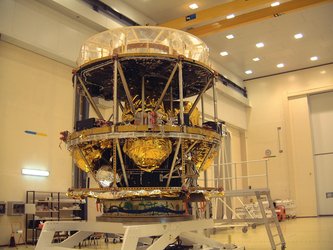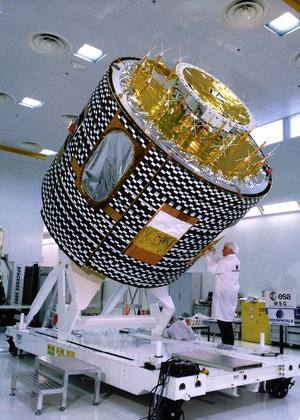MSG Launch Diary - week 3
02 June 2002
No work on Sunday, and the weather is relatively sunny. The team uses this leisure time to visit "Iles du Salut" or just to relax around the swimming pool.
The small islands, about 15 km off the Kourou coast, comprise the famous penal colony known popularly as "Devil's Island". It was founded in 1852 and used largely for political prisoners (the most celebrated was Albert Dreyfus.) Although conditions were probably not as sordid as in other prison camps in French Guiana, the island's name became synonymous with the horrors of the system. The penal colonies were phased out between 1938 and 1951.
01 June 2002
We continue to check the good health of the satellite in configurations as close as possible to the flight nominal and redundant configurations.
At the end of the day, to celebrate the "Spacecraft Good Health" and to maintain the good spirits for the MSG Launch Campaign Team, we organise a nice party.
31 May 2002
The satellite reference tests start. These tests check spacecraft telemetries in flight-standard operational configurations. They are used as a synthetic satellite health check-up.
30 May 2002

An important event for the main instrument is performed -- the SEVIRI scan mirror is unlocked successfully!
The Launch Locking Device (LLD) clamps the scan mechanism during transport and launch. To avoid damage to the scan mechanism, the scan mirror needs to be locked during transport and launch and to be unlocked afterwards.
Following the SEVIRI tests, the heater is tested and no problems are found. We are having a good day!
29 May 2002
All is going well. The tests of the telemetry, tracking and control (TT&C) subsystem tests are completed without any problems.
A key point has been reached -- to ascertain that all planned activities are completed (and no unplanned ones are needed!), so we can proceed to the next step, the release of the SEVIRI scan mirror.
SEVIRI (for Spinning Enhanced Visible and Infra-Red Imager) is the satellite's main instrument. Earth images are obtained by a bi-dimensional Earth scan, combining the satellite spin and the scan mirror rotation – a rapid scan from east to west, thanks to the satellite's rotation around its spin axes (at 100 rpm), and a slow scan from south to north with the scanning mechanism, which rotates the scan mirror in 125.8 µrad steps.
28 May 2002

The Electrical Power System (EPS) tests are still in progress. Today the Active Thermal Control performance test is run to check the heaters on various equipment. Next in line is the Data Handling Sub-System (DHSS) with the Central Data Management Unit (CDMU) reset and safe mode tests.
The Data Handling Subsystem (DHSS) provides all telemetry acquisition and processing, and forwards telemetry to the Telemetry, Tracking and Command (TTC) subsystem for transmission to Earth. It consists of three physical units, the CDMU and two Remote Terminal Units (RTUs). Commands and acquisition are sent out from the CDMU to the different subsystems of the satellite via the RTUs, or via the SEVIRI Functional Control Unit (FCU).
Also, the eagerly awaited final version of the satellite database is delivered to EUMETSAT, the European organisation for the exploitation of meteorological satellites.
27 May 2002

The platform tests start with the Electrical Power Subsystem (EPS). The EPS is formed from five separate elements: a solar-array photovoltaic energy source; two nickel-cadmium batteries; a Power Control Unit (PCU); a Power Distribution Unit (PDU); and a Pyrotechnic Release Unit (PRU).
Electro Explosive Device (EED) continuity and insulation checks as well as performance tests, are finished without problems. These tests ensure there will be no surprise short circuits!















 Germany
Germany
 Austria
Austria
 Belgium
Belgium
 Denmark
Denmark
 Spain
Spain
 Estonia
Estonia
 Finland
Finland
 France
France
 Greece
Greece
 Hungary
Hungary
 Ireland
Ireland
 Italy
Italy
 Luxembourg
Luxembourg
 Norway
Norway
 The Netherlands
The Netherlands
 Poland
Poland
 Portugal
Portugal
 Czechia
Czechia
 Romania
Romania
 United Kingdom
United Kingdom
 Slovenia
Slovenia
 Sweden
Sweden
 Switzerland
Switzerland





























